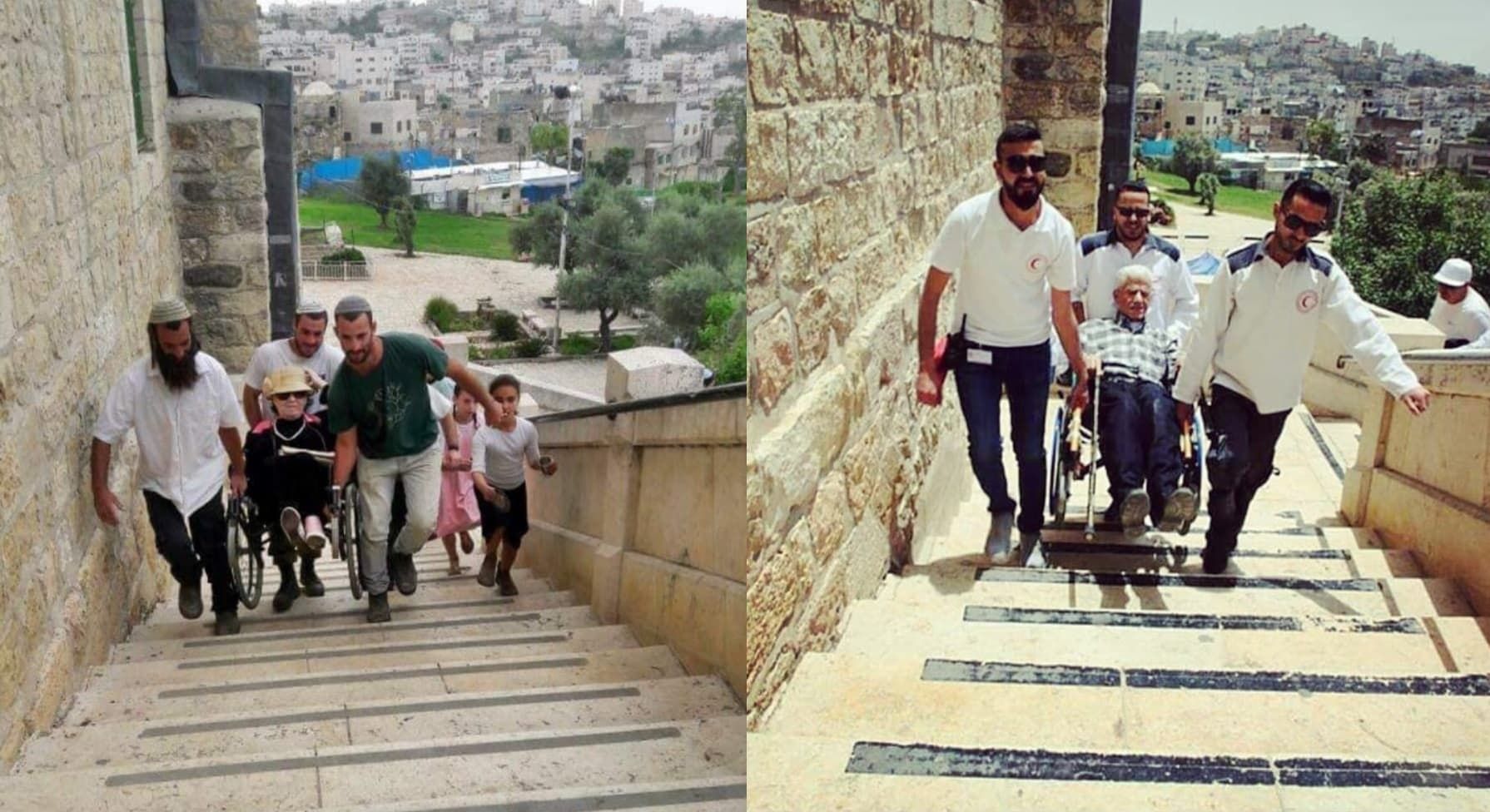While Jerusalem is undoubtedly the most hotly-contested site in the Holy Land, with both Jewish and Muslim ties to the city being reflected in the modern claims of Israel and the Palestinians, events in another city, almost 20 miles away, have the potential to set the region alight.
And now a new development in Hebron is in the headlines: the construction of an elevator outside the Cave of the Patriarchs complex.
According to both Jewish and Islamic tradition, the cave and adjoining field were purchased by Abraham as a burial plot. A large rectangular building, dating to the era of King Herod, was built over the cave and served as a synagogue. During Byzantine rule of the region, the structure was converted into a basilica and functioned as a Christian holy place. Later, it was conquered by the Muslims and transformed into the Ibrahimi Mosque. Over the following centuries, the Crusaders retook and again lost control of the site to Muslims.
Fast forward to 1967 and Israel gained control of the shrine when it came into possession of the West Bank, which had been occupied for two decades by Jordan. Wishing to keep the peace, the Israeli government authorized an arrangement in which equal access to the site was granted to Muslims and Jews. The complex was divided into a synagogue and mosque, with Jewish worshippers given access to numerous small tombs, and the large, grand tomb of Isaac attended by Muslim pilgrims.
For ten days of special importance in the Islamic calendar, Muslims are given access to the entirety of the site. The same arrangement applies for ten dates on the Hebrew calendar, during which Jews are given exclusive access. Each day, a Muslim cleric guarded by Israeli armed forces goes through the Jewish side, and ascends the minaret to issue the call to prayer for Muslims. Everything is carefully arranged in order to ensure maximum freedom of religion for both Jews and Muslims.
Hebron was in the past the scene of the numerous massacres of Jews at the hands of their Muslim neighbours, including the 1929 rampage which left 67 Jewish residents dead; it was the birthplace of the settlement movement in 1968; it was the location of the killing of 29 Muslim pilgrims by Kach supporter Baruch Goldstein in 1994; and over the Second Intifada it was the location of countless Palestinian attacks, including one that killed a three-month-old baby, and from where numerous suicide bombers departed to murder Jews in Jerusalem. Around 1,000 Jewish Israelis live in the city center, surrounded by approximately 190,000 Palestinian Arabs.
In recent years, it has also been the scene of repeated stabbings and attempted stabbings of Israeli soldiers by Palestinians, as well as guided tours run by radical organisations seeking to falsely depict this uniquely intense city as a “microcosm of the occupation” (often given to foreign tourists and celebrities from abroad with very little knowledge of Israel’s security considerations).
Given the extreme sensitivity of both Muslims and Jews to the administration of the Cave of the Patriarchs, Israel’s rule has been largely a lesson in balancing the need to ensure true freedom of religious expression for all while maintaining the security of the site. However, as the years pass by, the site’s infrastructure has become increasingly outdated. Although over one million people visit the holy site each year, access to both Muslim and Jewish sanctuaries is only possible by climbing several steep flights of stairs.
The problem has not escaped the attention of leading Israeli politicians. As Defense Minister Benny Gantz noted in July 2020, “It is unacceptable that a site as important to both Jews and Muslims as the Tomb of the Patriarchs would be inaccessible to those who are disabled.”
However, for years the Palestinian-run Municipality of Hebron has refused to co-operate on any significant changes to the site. To that end, Israel declared itself responsible for developing the site, and Gantz approved plans to construct an elevator there.
At its core, the elevator imbroglio is not about the elevator itself, but about whether Israel has the right to make this unilateral change. Israeli politicians and representatives of Hebron’s Jewish community argue that ensuring access to all members of the public, including the handicapped, is long overdue after years of Palestinian unwillingness to co-operate.
Israeli activist Shai Glick told HonestReporting that he initiated the process in 2015, when he noticed that there were 96 steps over two flights of stairs on the Jewish side of the complex, and 20 steps on the Muslim side. With both Jewish and Muslim entrances impassable for those restricted to wheelchairs, he filed for planning permission, only to be denied by the Palestinian-run Municipality of Hebron.
In the meantime, handicapped Jewish and Muslim worshippers have no choice but to be carried up the stairs by others.

“Two peoples, the same trouble,” observed Glick.
“The understanding was that the Arabs would build, but Israel would fund the entire project,” he said. “We tried tens and tens of times, we even almost succeeded in getting the project over the line, but each time they refused.”
Glick and others are quick to point out that as both Israel and the Palestinian Authority are signatories to the Convention on the Rights of Persons with Disabilities, a human rights treaty intended to protect the rights and dignity of individuals with disabilities, both are obligated to make the site accessible to all, or at least not prevent it being made accessible.
In the face of repeated failures to successfully engage the Palestinians, and unwilling to wait any longer, Israel approved the plans without Palestinian involvement. The estimated $1.4 million project includes an elevator, as well as a path between the entrance and an adjacent parking area. A bridge connecting the elevator to the entrance is also included in the plans.
Opponents of the project insist that Israel does not have the requisite authority to start construction, and some even claim that the building may harm the architectural integrity of the site — politicized claims that echo those surrounding the dangerously rickety Mughrabi bridge leading up to the Temple Mount.
Palestinian reports grossly mischaracterize the project, describing an attempt to “Judaise” what is often falsely characterised as a uniquely “historical Islamic site.” A wave of Palestinian social media content about the issue has surfaced in recent weeks, stoking tensions further. This comes on the back of bombastic statements by Palestinian leaders describing the plans as “tantamount to igniting a religious war in the region and in the world,” and a “war crime.”
With both the recent and ancient history of conflict in the city, Israeli authorities believe their decision-making process has been equanimous and fair. But as Palestinian misinformation about the construction continues to spread, and there have already been clashes between Palestinians and Israeli security forces, it may be only a matter of time until Palestinian anger over the issue causes a much larger conflagration.
Liked this article? Follow HonestReporting on Twitter, Facebook, Instagram and TikTok to see even more posts and videos debunking news bias and smears, as well as other content explaining what’s really going on in Israel and the region.
Featured Image: Wikimedia Commons, CC BY-SA 3.0



